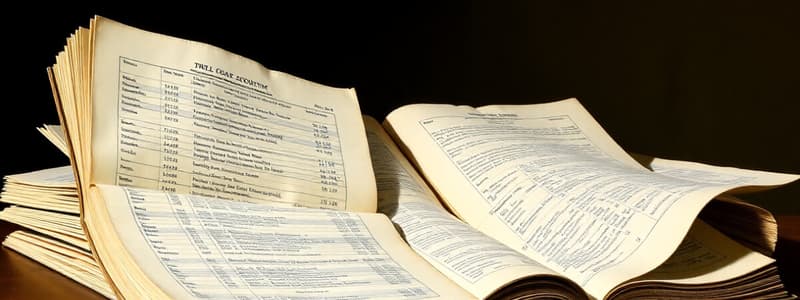Podcast
Questions and Answers
What is the primary principle behind the concept of Dual Aspect in accounting?
What is the primary principle behind the concept of Dual Aspect in accounting?
- Every liability is recorded without a corresponding asset.
- Transactions should only be recorded when cash changes hands.
- Assets must be recorded on the balance sheet without liabilities.
- For every debit, there is a corresponding and equal credit. (correct)
Which of the following best describes the Disclosure principle in accounting?
Which of the following best describes the Disclosure principle in accounting?
- All financial reports must communicate information that is reliable and understandable to users. (correct)
- Only material items affecting profits should be included in financial statements.
- Disclosure is only necessary for regulatory authorities.
- Only positive information about a business should be disclosed.
What does the Materiality principle allow regarding financial statement disclosures?
What does the Materiality principle allow regarding financial statement disclosures?
- Items that are not significant and do not influence user decisions need not be disclosed. (correct)
- Only insignificant items can be omitted from financial statements.
- All items must be disclosed regardless of significance.
- Materiality only applies to cash transactions.
What is the basic accounting equation derived from the Dual Aspect concept?
What is the basic accounting equation derived from the Dual Aspect concept?
Under the principle of Disclosure, what must be prioritized when preparing financial reports?
Under the principle of Disclosure, what must be prioritized when preparing financial reports?
Which of the following accounts is classified as a Liability?
Which of the following accounts is classified as a Liability?
Which account is categorized under Income/Gains?
Which account is categorized under Income/Gains?
Which of the following accounts would be classified as Expenditure/Loss?
Which of the following accounts would be classified as Expenditure/Loss?
Which of these accounts is considered an Asset?
Which of these accounts is considered an Asset?
Which account correctly represents Capital?
Which account correctly represents Capital?
What is the main characteristic of the Double Entry System of Book-keeping?
What is the main characteristic of the Double Entry System of Book-keeping?
Which statement correctly describes the Indian System of accounting?
Which statement correctly describes the Indian System of accounting?
What happens under the Double Entry System when there is an increase in assets?
What happens under the Double Entry System when there is an increase in assets?
What is a defining feature of the Single Entry System in accounting?
What is a defining feature of the Single Entry System in accounting?
What does a credit entry indicate in a business's financial transactions?
What does a credit entry indicate in a business's financial transactions?
What is revenue arising from business transactions called?
What is revenue arising from business transactions called?
What do you call the excess of gross profit over operating expenses?
What do you call the excess of gross profit over operating expenses?
What is an expenditure that is revenue in nature but not fully utilized within a year called?
What is an expenditure that is revenue in nature but not fully utilized within a year called?
What do you call the amount that a seller deducts from the list price at the time of sale?
What do you call the amount that a seller deducts from the list price at the time of sale?
What is a person called to whom a business owes money for goods or services?
What is a person called to whom a business owes money for goods or services?
Who is considered the originator of the Double Entry Book-Keeping System?
Who is considered the originator of the Double Entry Book-Keeping System?
What principle is the Double Entry Book-Keeping System based on?
What principle is the Double Entry Book-Keeping System based on?
What is the primary purpose of preparing a Bank Reconciliation Statement?
What is the primary purpose of preparing a Bank Reconciliation Statement?
Which of the following methods is used to calculate Depreciation?
Which of the following methods is used to calculate Depreciation?
Which significant date is celebrated as International Accounting Day?
Which significant date is celebrated as International Accounting Day?
What type of errors are rectifiable and require adjustments in accounts?
What type of errors are rectifiable and require adjustments in accounts?
What distinguishes Fixed Assets from Current Assets?
What distinguishes Fixed Assets from Current Assets?
What is the function of a Suspense Account in accounting?
What is the function of a Suspense Account in accounting?
Flashcards are hidden until you start studying
Study Notes
Cash Book and Banking Transactions
- Ability to prepare and balance various Cash Books.
- Understanding of accounting treatments for banking transactions and contra entries.
- Capability to prepare multiple Subsidiary Books.
- Knowledge of different Bank Documents and their formats.
- Distinction between Cash Book and Pass Book.
Bank Reconciliation Statement
- Awareness of reasons for discrepancies between Cash Book and Pass Book balances.
- Skill to competently prepare a Bank Reconciliation Statement.
- Understanding the concepts, methods, and significance of Depreciation.
- Differentiation between Fixed Assets and Current Assets.
Depreciation
- Ability to calculate Depreciation on various fixed assets.
- Knowledge of Straight Line Method and Written Down Value Method for Depreciation calculations.
- Understanding of Rectification of Errors: definition and effects.
- Familiarity with different types of errors and examples.
Rectification of Errors
- Skills in detecting and rectifying accounting errors.
- Understanding the concept and necessity of Suspense A/c.
- Ability to prepare a Suspense A/c.
Dual Aspect Concept
- Each business transaction has dual aspects (debit and credit).
- Example: Starting a business with cash creates both an asset (cash) and a liability (amount owed to the owner).
- Basis for the double entry bookkeeping system: Capital + Liabilities = Assets.
Disclosure Principle
- Requirement for accounts to disclose all material information.
- Accounting reports must present full and fair information to stakeholders.
- Financial position and performance should be transparently disclosed.
- Information must be relevant, reliable, and comparable for users.
Materiality Principle
- Financial statements should disclose all material items influencing user decisions.
- Non-significant items may not need disclosure as they lack relevance.
- Subjective nature: Materiality depends on transaction amount, business size, and user's needs.
Double Entry Book-Keeping System
- Defined as the scientific method of recording monetary transactions in accounting.
- Originated from Luca Pacioli in 1494; recognized as International Accounting Day.
- Each transaction involves two accounts, representing the giver and the receiver of benefits.
Methods of Recording Accounting Information
- Two main systems: Indian and English systems.
- Indian System: Records in local languages (Mahajani Deshinama), primarily for small businesses, not based on double entry principles.
- English System:
- Single Entry System: Incomplete and unscientific, records only cash and personal accounts, suitable for small businesses.
- Double Entry System: Comprehensive and scientific, accounting captures both credit and debit aspects.
Classification and Golden Rules
- Accounts categorized into Assets, Liabilities, Income, Expenditure, and Capital.
- Golden rules for classification help in applying accounting principles effectively.
- Understanding the Modern Approach of recording transactions focused on key categories: Assets, Liabilities, Capital, Expenses, and Income.
Illustrations for Classification
- Accounts showcased under respective classifications demonstrate the application of theory to practice, aiding in understanding the flow of financial information.
Studying That Suits You
Use AI to generate personalized quizzes and flashcards to suit your learning preferences.




